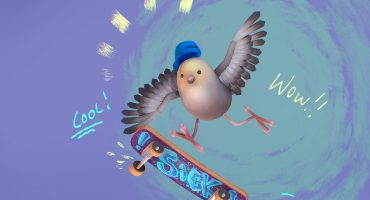In Art Spotlight, we invite Sketchfab artists to talk about one of their designs.
I’m Joel Zakrisson, a 3D art student at Future Games in Stockholm, Sweden. My main specialization is environmental art, but I love all kinds of modeling and tend to take on vehicles and creatures as well. Now, we’re going to take a look at my latest diorama, where fishermen get some unexpected company….
https://skfb.ly/VpQw
The Steam Tug
The project initially started during a trip to Gothenburg the summer of 2015. I was inspired by real boat miniatures and decided to create one as a high poly modeling exercise, without any intention of it becoming a diorama.
I tweaked the high poly’s shapes with the lattice tool in Maya, to give it a stylized look.

I decided to bake the boat to a low poly model during a texturing course last fall. Since the course was held by Quixel I chose to texture it in DDO. I do however, prefer Substance Painter and Substance B2M, so I used those programs for the rest of the scene.
When texturing I rely a lot on realistically generated masks for worn edges, rust and dirt. I encourage you to base your workflow on masking and to mainly use brushes for editing masks.

Blockout and Composition
The production of the diorama didn’t start until this summer. I had a rough idea about fishermen meeting seals, but most of the story appeared as I blocked out the scenario in Maya.

I thought about compositional guidelines while placing objects, aligning them in circles around the boat. Character interactions are smaller focal points, leading you from one area to another, following the steam tug’s direction.

Inspiration for the scene was mainly taken from miniature models and islands around the North Atlantic Ocean.

Fishermen and Seals
For the fishermen, I generated a child mesh with MakeHuman, to get stylized proportions. I could then sculpt clothes and cartoon features on the mesh in ZBrush. Animals were sculpted from scratch, but sometimes with modified low polys. For example, I exaggerated the seal’s frontal parts to enhance its cuteness.

The fur material is a tiled wool texture divided into four different quads with varying degree of brightness and transparency. It was assigned to four extracted layers wrapping around the seal’s body, where the outer layers are the brightest and most transparent. The same technique was used for the scene’s baby birds and the colossi in Shadow of the Colossus.

Fish are traced from images with the create polygon tool in Maya. They’re all extruded for some extra thickness towards the middle.

Environment
These are all of the assets used in the scene. Everything except for the fishing equipment is duplicated and reused in the environment. Rocks function as a foundation, while the other props are used as decoration.

To create the surface of the water I generated a height map from an ocean texture in Substance B2M. I applied the height map to a plane in Maya with the sculpt geometry tool, to get the wave shape. The transparent edges are just extruded down from the surface with another material applied.

Foam was created in the same way, but with a wave as the original texture. To complement the foam I used planes with transparent splash-textures applied.

Sketchfab
While the original renders were done in Marmoset, the transition to Sketchfab went really smoothly. Since everything was composed in Maya, I could just export the scene as one mesh and then apply all textures directly in the browser.
Sketchfab is really one of the best ways of presenting dioramas, since it lets the viewers explore all hidden secrets without limits. There are lots of details you easily miss in regular renders. Go and have a look for yourself!







